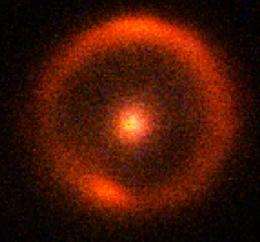Astronomers find a dark matter galaxy far, far away

(ĖĮÐÄĘÓÆĩOrg.com) -- A faint âsatellite galaxyâ 10 billion light years from Earth is the lowest-mass object ever detected at such a distance, says University of California, Davis, physics professor Chris Fassnacht, who aided in the satelliteâs discovery.
The find, described in a paper published online today (Jan. 18) in the journal Nature, could help astronomers find similar objects and confirm or reject theories about the structure of the cosmos.
Theory predicts that galaxies should be surrounded by halos of smaller, satellite blobs of mass, according to Fassnacht. Astronomers have detected such satellites around our own galaxy, the Milky Way, and nearby.
But they had not previously detected the predicted satellites of more distant galaxies.
Because most of the mass of galaxies is made up, not of stars, but of âdark matter,â which does not absorb or emit light, these distant objects may be very faint or even completely dark.
The team looked for faint or dark satellites of distant galaxies using a method called gravitational lensing. Using the Keck II telescope at the W.M. Keck Observatory on Mauna Kea, Hawaii, with âadaptive optics,â they found two galaxies aligned with each other, as viewed from Earth.
The nearer objectâs gravitational field deflects the light from the more distant object as the light passes through or near the other objectâs gravitational field, creating a distorted image as if passed through a lens. By analyzing these distorted images, the researchers could determine if there were any satellite galaxies clustered around the âlensâ galaxy.
Adaptive optics make constant, tiny adjustments to the telescope mirror to compensate for the effects of the Earthâs atmosphere. As a result, the Keck telescopes can achieve higher resolution than the Hubble Space Telescope.
The technique can now be applied to many more galaxies, Fassnacht said. âAs we collect more objects, we can do more precise tests of our simulations and make predictions about the structure of the universe,â he said.
First author Simona Vegetti, a postdoctoral researcher at the Massachusetts Institute of Technology, said: âNow we have one dark satellite, but suppose that we donât find enough of them â then we will have to change the properties of dark matter.
âOr, we might find as many satellites as we see in the simulations, and that will tell us that dark matter has the properties we think it has.â
Fassnacht and Vegetti worked with Leon Koopmans of the University of Groningen, Netherlands; David Lagattuta, now at the Swinburne University of Technology, Australia; Matthew Auger, UC Santa Barbara; and John McKean of the Netherlands Foundation for Research in Astronomy. Lagattuta and Auger are former graduate students in Fassnachtâs lab, and McKean was a postdoctoral researcher at UC Davis.
More information:
Provided by UC Davis



















